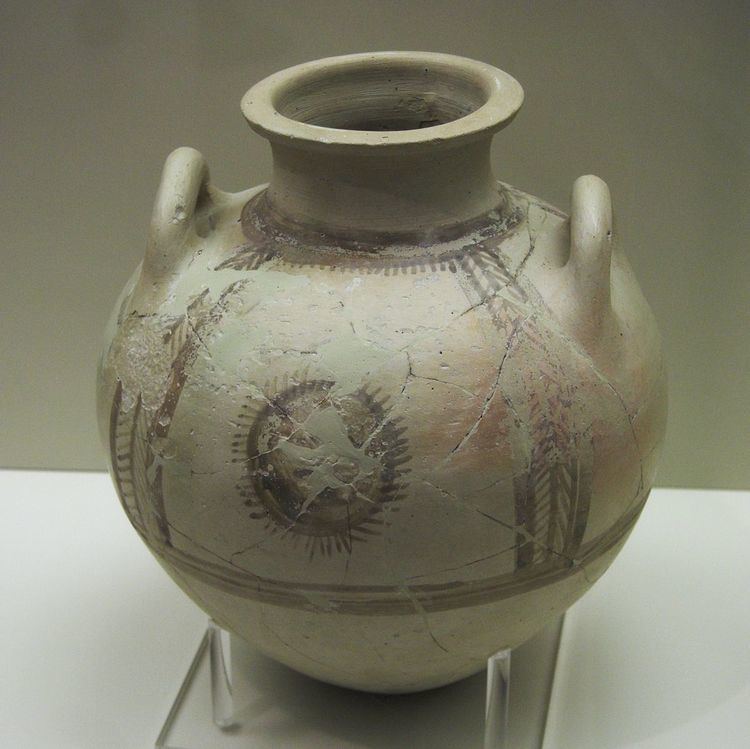 | ||
Minyan ware is a broad archaeological term describing varieties of a particular style of Aegean pottery associated with the Middle Helladic period.
Contents
Term
In the history of Aegean prehistoric archaeology, Heinrich Schliemann was the first person to coin the term "Minyan" after he discovered a distinct variety of dark-burnished pottery at Orchomenos (the mythical home of King Minyas). Some of his contemporaries referred to the pottery as "Orchomenos Ware". However, the term "Minyan Ware" ultimately prevailed since it romantically recalled the glorious (though tenuous) Minyans of Greek mythology.
Origins
At first, Alan Wace and Carl Blegen did not yet associate Minyan Ware with the "advent of the Greeks". Both archaeologists regarded the sudden appearance of Minyan Ware as one of two interruptions in the unbroken evolution of Greek pottery from the Neolithic up until the Mycenean era. Ultimately, they concluded that "Minyan Ware indicates the introduction of a new cultural strain."
Prior to 1960, Minyan Ware was often associated with northern invaders having destroyed Early Helladic culture (1900 BC) and introducing Middle Helladic culture into the Greek peninsula. However, John L. Caskey conducted excavations in Greece (i.e. Lerna) and definitively stated that Minyan Ware was in fact the direct descendant of the fine gray burnished pottery of Early Helladic III Tiryns culture. Caskey also found that the Black or Argive variety of Minyan Ware was an evolved version of the Early Helladic III "Dark slipped and burnished" pottery class. Therefore, Minyan Ware was present in Greece since between 2200 and 2150 BC. There is nothing particularly "northern" regarding the ceramic progenitors of Minyan Ware. The exception, however, entails the spread of Minyan Ware from central Greece to northeastern Peloponnese, which can be seen as "coming from the north" with respect to the Peloponnese. Currently, there is uncertainty as to how Minyan Ware arrived in Greece or how it was indigenously developed. The Late Helladic phase may be associated with the arrival of Indo-European speakers as overlords; Greek technical terms for pottery are not Indo-European, suggesting a continuity of potters and their techniques from earlier times.
Forms and styles
Minyan Ware is a form of monochrome burnished pottery produced from extremely fine or moderately fine clay. Varieties of Minyan Ware entail Yellow, Red, Gray, and Black (or Argive). Open forms such as goblets and kantharoi are the most common shapes in all types of Minyan Ware. Goblets and kantharoi are technically evolved versions of the Bass bowl and kantharos of the Early Helladic III Tiryns culture.
Gray Minyan Ware, specifically, has angular forms that may reflect copies of metallic prototypes. However, such a theory is difficult to substantiate given the fact that metallic objects from the Middle Helladic period are rare and metallic vessels are almost non-existent. Yet, the angular forms of this particular pottery style may in fact be derived from the common use of the fast potter's wheel. "Ring stems" (or highly ribbed pedestal feet) are an important characteristic of Middle Helladic II and Middle Helladic III Gray Minyan Ware in central Greece. Of course, this characteristic is also present on Middle Helladic III Yellow Minyan Ware goblets from Corinth and the Argolid. During the final phase of the Middle Helladic period, shallowly incised rings more or less replaced goblet feet and "ring stems" in northeastern Peloponnese.
Minyan Ware from the Middle Helladic I period is decorated in the form of grooves on the upper shoulder of kantharoi and bowls. During the Middle Helladic II period, stamped concentric circles and "festoons" (or parallel semicircles) became a common characteristic of decoration especially on Black (or Argive) Minyan Ware.
Areas of production
Gray Minyan Ware is mostly found in central Greece. It is also common in the Peloponnese during the Middle Helladic I and Middle Helladic II periods. Black (or Argive) Minyan Ware is common in northern Peloponnese and is mostly decorated with stamped and incised ornaments. Red Minyan Ware is commonly found in Aegina, Attica, the northern Cyclades and Boeotia. Yellow Minyan Ware first appears during the Middle Helladic II and Middle Helladic III periods. Due to its light surface color, this particular variety of pottery is decorated with dark matt-paint. This has led archaeologists to regard Yellow Minyan Ware as "Matt-Painted" instead of "Minyan".
Anatolian Grey Ware
Pottery very similar to Grey Minyan ware is known in Anatolia, dated around 14th–13th centuries BC. It has been suggested that "North-West Anatolian Grey Ware" should be used for this type of pottery. Around 2002, the term “Anatolian Grey Ware” became utilized by scholars.
